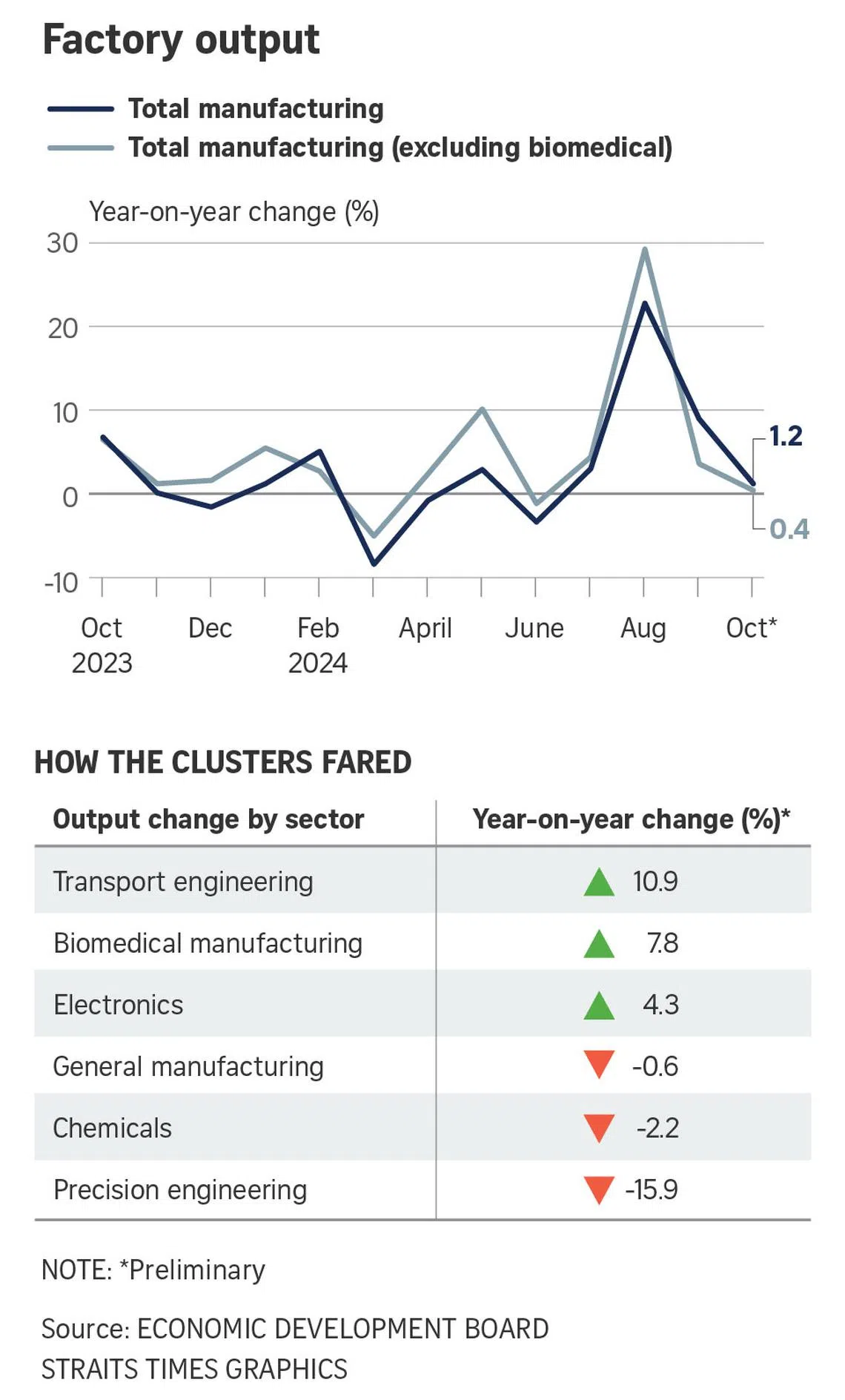Singapore factory output rises at slower pace of 1.2% in October
Sign up now: Get ST's newsletters delivered to your inbox

The electronics industry, which accounts for nearly half of Singapore’s manufacturing output, saw an increase of 4.3 per cent year on year, higher than the revised 0.9 per cent rise in September.
PHOTO: ST FILE
Follow topic:
SINGAPORE - Singapore’s manufacturing output rose for a fourth straight month in October, albeit at a slower pace of expansion.
Total output crept up 1.2 per cent year on year, after a downwardly revised 9 per cent rise in September
The growth was also below forecast, with economists in a Bloomberg poll tipping 2.6 per cent.
Excluding the more volatile biomedical industry, output increased by just 0.4 per cent, according to data from the Economic Development Board on Nov 26.
On a seasonally adjusted month-on-month basis, factory production edged up 0.1 per cent. Excluding biomedical manufacturing, it dropped 1.9 per cent.
The electronics industry, which accounts for nearly half of Singapore’s manufacturing output, saw an increase of 4.3 per cent year on year, higher than the revised 0.9 per cent rise in September.
Within the cluster, semiconductor production grew 2.1 per cent. Other electronic modules and components rose 11.9 per cent, while computer peripherals and data storage expanded 22.9 per cent, and infocomms and consumer electronics added 20.3 per cent.
DBS Bank economist Chua Han Teng said that the outlook for Singapore’s electronics cluster remains positive, driven by the ongoing upturn in the global semiconductor cycle.
“Resilient external demand and favourable base effects are expected to boost Singapore’s manufacturing expansion during the final months of 2024,” he added.
The precision engineering cluster was the worst performer in October, shrinking 15.9 per cent over the same month in 2023.
Within the cluster, the precision modules and components segment rose 6.8 per cent, led by higher output of plastic precision components, optical instruments and electronic connectors.
But the machinery and systems segment declined 21.3 per cent, compared with a high production base of semiconductor equipment in 2023.
Output in the transport engineering sector grew 10.9 per cent in October over the same month in 2023.
The aerospace segment led the charge, growing 16.5 per cent, sustained by higher production of aircraft parts and more maintenance, repair and overhaul jobs from commercial airlines. The land segment also performed well, rising 7.8 per cent.
The marine and offshore engineering segment increased 3.2 per cent on the back of higher project milestones met.

Biomedical manufacturing output increased 7.8 per cent year on year.
Within the cluster, the pharmaceuticals segment grew 10.5 per cent on account of a different mix of active pharmaceutical ingredients being produced, compared with a year ago.
The medical technology segment increased 1.6 per cent to meet continued export demand for medical devices.
The chemicals cluster saw output decrease 2.2 per cent year on year.
The “other chemicals” segment led the charge with an 11.4 per cent expansion on account of higher output of fragrances. Petrochemicals also performed well, rising 4.6 per cent.
However, the petroleum segment decreased 0.3 per cent, while the specialities segment plunged 31.7 per cent due to lower production of mineral oil additives and biofuels.
General manufacturing output decreased 0.6 per cent in October.
Within the cluster, the printing segment grew 7.4 per cent, while food, beverages and tobacco rose 4.6 per cent on the back of higher production of milk powder and animal feeds.
But the miscellaneous industries segment declined 9.1 per cent, led by lower production of structural metal products and paperboard containers and boxes.
Maybank economist Chua Hak Bin said that anticipated tariffs by US President-elect Donald Trump are likely to accelerate production and shipments ahead of his inauguration in January.
“Higher tariffs on China could accelerate the shift in manufacturing supply chains and production towards South-east Asia, including Singapore, which will boost investments and factory output,” he said.


